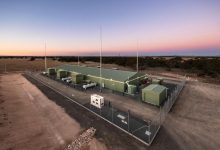South Australia’s second big battery – the less heralded Dalrymple North battery energy storage system – has been busy since coming into service six months ago, earning money from frequency control services and cap trading, and keeping the lights on in its local area.
Dalrymple is not as big as the Tesla big battery, it ranks at 30MW/8MWh versus 100MW/129MWh. Nor is it as flash – it wasn’t borne from a series of billionaire tweets or officially opened by Elon Musk.
And the Dalrymple battery was not built in 100 days. Far from it. But it does attract interest from within the energy world because it is designed to do a bunch of things that the Tesla battery at Hornsdale can’t do, and these could be fundamental to the design and running of the future clean energy grid.
Dalrymple is officially known as the ESCRI-SA, and is located near the Wattle Point wind farm on the Yorke Peninsula, west of Adelaide. It uses Samsung batteries and ABB inverters and controls.
It is designed primarily to operate in the FCAS market, which the Tesla battery can and does do quite profitably, and to trade caps, and help manage the inter-connector to Victoria. But it is also configured to allow “islanding” of the Yorke Peninsula, and ensure that the local power supply is maintained in case of grid problems elsewhere.
The combination of these services is so complex – and unique – that it took a while for the battery people to get the configuration right, but it eventually came on stream late last year, and has been fully operational from earlier this year.
And now, for the first time, thanks to its “knowledge sharing” obligations that come as part of funding from the Australian Renewable Energy Agency, we have some insight into how it is operating. (See presentations here).
The first thing that should be noted is that it has kept the lights on when needed. Two incidents stand out: One, an unexpected event that occurred in late March; another when some planned maintenance required the battery to put the Yorke Peninsula and its households and local business into islanding mode for more than seven hours.
And it worked. Almost perfectly, but not quite.
On March 29, ElectraNet reports, when an unexpected incident in the network caused an outage, this forced the Dalrymple battery to go into “islanding” mode, which it did quite successfully for the duration of the 30 minute outage, when load was around 3MW. No load was lost during the outage.
On April 6, a planned sub-station upgrade in the early hours put the battery into islanding mode again, this time with a 1MW load and for a planned seven and a half hour outage.
This was also working fine until the return of one of the feeders caused a “vector shift” that caused the battery to trip for a half-hour period. That is unlikely to happen again, as the controls have been adjusted.
The battery has successfully ridden through several transmission faults, and provided significant reactive power to support network voltage during the faults.
However, another issue that occurred over summer was the susceptibility of the battery performance to extreme heat – an issue that will be top of mind for many battery storage developers operating in Australia.
In January and February, the heat reduced its availability from the contracted 96 per cent to just 91 per cent, although the blame is put on faulty air conditioning units, which are now being addressed and additional units are being purchased. The use of air-con added to the standby power consumed.
 But it is also making money. This presentation from AGL Energy suggests total revenue of around $1 million from the battery since the start of the year – just a fraction of the revenue earned by the bigger Tesla battery at Hornsdale, but significant nonetheless.
But it is also making money. This presentation from AGL Energy suggests total revenue of around $1 million from the battery since the start of the year – just a fraction of the revenue earned by the bigger Tesla battery at Hornsdale, but significant nonetheless.
 Cap trading is more sporadic, and about one-tenth of the revenue earned from the FCAS market, even though that part of the battery has been operating for longer.
Cap trading is more sporadic, and about one-tenth of the revenue earned from the FCAS market, even though that part of the battery has been operating for longer.
But between the two of them they appear to have a handy margin, given that the charging cost is about the same as the money earned from CAP trading. The FCAS revenue appears to be pure profit. Maybe there are further costs not shown here, but it would be consistent with the sort of margins achieved by the Tesla battery at Hornsdale.
AGL also noted that the net energy consumed by the BESS is higher than expected. This is largely driven by the standby load and energy for cooling. It also noted that “over temperature protection” has activated at times of extremely high ambient temperature, and this was being addressed by the purchase of more air con units.
One final point. AGL says it is clear that the battery can provide so-called “synthetic inertia” that can help slow the rate of change in frequency. But it is having a hard time convincing the regulators that it can do a better job than fast frequency response usually provided by conventional generators.
“The (South Australia Office of Technical Regulator) is yet to accept that synthetic inertia can make a greater contribution to inertia than Fast Frequency Response,” it notes. Perhaps that might be something targeted in the next government tender.









